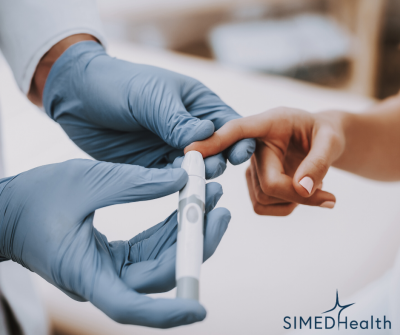
30.3 million people in the U.S. are living with diabetes. That's 1 in 11 people! November is American Diabetes Education Month, and we talked to Dr. Seth Perkins, one of our SIMEDHealth Primary Care Physicians serving our Lady Lake community. Dr. Perkins filled us in on the difference between the types of diabetes, what its symptoms are, and what patients can do to try and prevent diagnosis.
1. What is diabetes, and what is the difference between type 1 and type 2?
"Diabetes is a disease where the body does not properly break down carbohydrates (i.e., sugars and starches), and sugar levels are high in the blood and the urine," says Dr. Perkins. Type 1 diabetes is a condition where the body is not producing enough insulin, a hormone that causes sugar to move into the cells of our bodies to be used for energy. Type 2 diabetes is when the body has a resistance to insulin and requires more and more insulin to be produced, exceeding our body's capacity to do so. The main treatment option for Type 1 patients is insulin. Type 2 patients take oral medications initially and may require insulin or other injection medications as time passes.
2. What causes diabetes for both types?
Dr. Perkins says, "Type 1 forms because of the destruction of cells in the pancreas that produce insulin." Typically, but not always, patients receive a Type 1 diagnosis at a younger age. Type 2 has causes related to multiple issues, including genetics and the environment in which someone grew up or presently lives. Patients usually receive a Type 2 diagnosis at an older age. "Diet and lifestyle play significant roles in the causes of type 2 diabetes," explains Dr. Perkins.
3. What are its symptoms?
Dr. Perkins says, "The most frequent symptoms of diabetes include frequent urination even at nighttime, increased thirst resulting in drinking more fluids than usual, blurry vision, and unexplained weight loss. Type 2 diabetics, however, if caught early, can often present without symptoms."
4. What can people do to prevent it?
The best way to prevent diabetes is to lead a healthy lifestyle. Regular physical activity is particularly important. Dr. Perkins states, "A minimum of one hundred fifty minutes of moderate aerobic exercise is recommended per week. Moderate aerobic exercises include walking briskly, dancing, and swimming." Additionally, a healthy diet is essential. A diet focused on eating a wide variety of healthy foods is more likely to be followed long-term. Weight loss improvement is also highly recommended, as obesity is a potential risk for developing diabetes. Smoking doesn't cause diabetes, but if it is present, smoking dramatically increases the long term complication risks.
5. After being diagnosed, what can patients do to stay healthy?
The above recommendations of physical activity, healthy diet, weight loss, and smoking cessation are helpful for people who are diagnosed. Dr. Perkins says, "Once diagnosed, diabetes education classes can give additional guidance. Meeting with a dietician or nutritionist is also an excellent way to develop a plan for staying healthy. Controlling blood pressure and cholesterol levels is essential, as it can increase the risk of developing heart disease. Not smoking or stopping smoking, as mentioned above. Most importantly, people that have been diagnosed should discuss this with their doctors, who will work with them to develop a personalized plan to help them make healthy decisions."